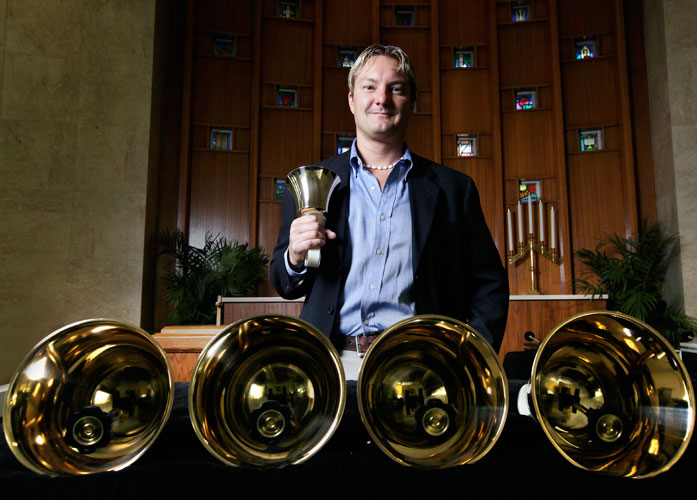VERO BEACH — When music rings out in Community Church’s newly renovated Grace Chapel Sunday night, it will be in celebration not only of the historic space’s restored beauty, but of the expanding regional handbell ensemble, the Atlantic Ringers.
The group is steadily taking on more difficult music and adding more proficient players, after being founded in 2010 by Ryan Kasten, the Church’s then newly arrived associate director of music and organist.
“We’re quickly becoming very respected,” says Kasten.
His colleagues at other churches are “thrilled to get us off to a good start with a good foundation. That means a lot,” he says. “People are taking the group seriously. It’s getting more advanced and more musical.”
In January, the church will host a weekend-long handbell festival with 10 churches from Jensen to Sebastian participating.
The group rehearses weekly for two-hour blocks, removing from their cases the 60 bells – comprising five octaves – and setting them up on foam-padded tables. Then they wait for their moment to strike.
And strike they do.
“The handbells are more of a percussion ensemble,” Kasten says.
The bells are not only shaken so their sides are hit by the inner clapper, they can be tapped with various mallets, rubbed around the edge with a dowel or knocked against the table, in a dozen different techniques.
Clutching two to four bells apiece, the ringers rarely take their eyes off the music, searching not only for the notes of their particular bells, but another mark on the score that will dictate exactly how to extract a particular sound.
“Your notes are on the page but most of the time you’re really focusing on striking the bells at the right moment.”
Making such a marvelous sound with so few performers, the Atlantic Ringers seem more magicians than musicians, eliciting a sound that swings from whimsical to nostalgic to haunting.
The concentration on faces as the ringers scrutinize the score confirms the reality: there is nothing as simple as jingling bells here. Even their attire in performance is somber – all black, down to the cotton gloves that keep the oils of their hands from tainting the lacquer-free brass of the bells.
Cost for bells ranges from $150 to $2,000, depending on size. The largest bells create the lowest notes.
“We just added the top half of the fifth octave, and we’re hoping to raise money in the freewill offering for a sixth octave,” he says.
Attrition is a problem Kasten can be proud to have. For a few, the music is getting too advanced to keep up.
“Fortunately, we’ve been able to replace people that thought it was getting to be a little bit more than they can handle,” Kasten says. “Those members have been nice enough to offer to fill in when someone can’t play.”
Without alternates, he says, a gap at the table can produce a hole in the music. At the same time, mistakes stand out like a sore thumb.
“There are a lot of laughs,” he says.
The traditional method he describes as “what the Salvation Army does” is sometimes used; ringers also use yarn mallets to hit the bell either in the air, where it vibrates longer, or as it sits on the table. Another method of playing involves rubbing the edge of the bell to make a sound like running a finger along a crystal wine glass.
It is those varying techniques that lend the bells their charm, naïve and piercingly clear one moment and bellowing and throaty the next.
“I’ve had a passion for bells ever since I was a kid,” says Kasten, who remembers going up in the bell tower of his church in Cape Girardeau, Missouri, guided by his uncle who maintained the bells.
“The bells tolled every day at noon and 6 p.m. and you would hear them for miles on end. It was like a European cathedral.”
In third grade, he was studying organ at the church when his teacher put together a group of ringers. He’s been playing ever since.
Kasten gave up a post with the family brick business – the Anheuser- Busch Brewery in St. Louis is built entirely of Kasten brick, he says – and instead majored in organ performance at Southeast Missouri University.
He earned a master’s degree in the same subject from the University of Nebraska, and took positions at a number of churches of various denominations.
He came to Florida specifically to study with Andre Thomas, a renowned professor in choral conducting at Florida State University. He earned a second master’s degree and is now wrapping up a doctoral degree in music.
His coursework is complete; he is trying to find time for the three recitals he is required to give in Tallahassee.
A bell ensemble he formed there has carried on in his absence, now known as the Capitol Ringers.
Kasten, 37, arrived in Vero in September 2009.
He wasted no time forming a group here. The groundwork had already been laid for him by Megan Mash of Sebastian’s United Methodist Church who led a handbell choir there up until economic hardships caused the group to disband. Mash now helps him direct.
While most major churches in Vero have invested in sets of bells, they are typically used only during church services to play hymns.
Kasten’s group plays popular and classical music as well.
Sunday’s concert will include selections from “Phantom of the Opera,” as well as compositions specifically for handbells.
The 1950s space now known as Grace Chapel was redone by two architects in Community’s congregation, Robert and Amy Banov, after the church decided last year to fix leaky windows and termite damage, remediate mold, replace carpet, change out pews and reconfigure the space.
Long-time members of the church’s congregation donated money to repair the aging chapel.
Sunday’s concert is at 7 p.m. at Grace Chapel at Community Church, 1901 23rd St., Vero. For more information, call (772) 469-2306.

